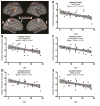Cortical thickness reduction in combat exposed U.S. veterans with and without PTSD
- PMID: 28279623
- PMCID: PMC5429865
- DOI: 10.1016/j.euroneuro.2017.02.010
Cortical thickness reduction in combat exposed U.S. veterans with and without PTSD
Abstract
We investigated the extent of cortical thinning in U.S. Veterans exposed to combat who varied in the severity of their posttraumatic stress disorder (PTSD) symptoms. In addition, we explored the neural correlates of PTSD symptom dimensions and the interactive effects of combat exposure and PTSD upon cortical thickness. Sixty-nine combat exposed Veterans completed high-resolution magnetic resonance imaging (MRI) scans to estimate cortical thickness. The Clinician Administered PTSD Scale (CAPS) and Combat Exposure Scale (CES) assessments were completed to measure current PTSD and historical combat severity, respectively. PTSD symptom dimensions (numbing, avoidance, reexperiencing, anxious arousal, and dysphoric arousal) were studied. Vertex-wise whole cerebrum analyses were conducted. We found widespread negative correlations between CAPS severity and cortical thickness, particularly within the prefrontal cortex. This prefrontal correlation remained significant after controlling for depression severity, medication status, and other potential confounds. PTSD dimensions, except anxious arousal, negatively correlated with cortical thickness in various unique brain regions. CES negatively correlated with cortical thickness in the left lateral prefrontal, regardless of PTSD diagnosis. A significant interaction between CES and PTSD diagnosis was found, such that CES negatively correlated with cortical thickness in the non-PTSD, but not in the PTSD, participants. The results underscore the severity of cortical thinning in U.S. Veterans suffering from high level of PTSD symptoms, as well as in Veterans with no PTSD diagnosis but severe combat exposure. The latter finding raises considerable concerns about a concealed injury potentially related to combat exposure in the post-9/11 era.
Keywords: Combat; Cortical thickness; Neuroimaging; PTSD; Veteran.
Published by Elsevier B.V.
Conflict of interest statement
Conflict of Interest
Dr. Krystal has served as a scientific consultant to the following companies (the Individual Consultant Agreements listed are <$10,000 per year): Aisling Capital, Astellas Pharma Global Development, AstraZeneca Pharmaceuticals, Biocortech, Brintnall & Nicolini, Easton Associates, Gilead Sciences, GlaxoSmithKline, Janssen Pharmaceuticals, Lundbeck Research USA, Medivation, Merz Pharmaceuticals, MK Medical Communications, Hoffmann–La Roche, SK Holdings, Sunovion Pharmaceuticals, Takeda Industries, and Teva Pharmaceutical Industries. He is on the Scientific Advisory Board for the following companies: Abbott Laboratories, Bristol-Myers-Squibb, Eisai, Eli Lilly, Forest Laboratories, Lohocla Research Corporation, Mnemosyne Pharmaceuticals, Naurex, Pfizer Pharmaceuticals, and Shire Pharmaceuticals. He holds <$150 in exercisable warrant options with Tetragenex Pharmaceuticals. He is on the Board of Directors of the Coalition for Translational Research in Alcohol and Substance Use Disorders. He was the principal investigator of a multicenter study in which Janssen Research Foundation provided drug and some support to the Department of Veterans Affairs. He is Editor of Biological Psychiatry. He has a patent on dopamine and noradrenergic reuptake inhibitors in treatment of schizophrenia (patent number 5447948) and is a coinventor on a filed patent application by Yale University related to targeting the glutamatergic system for the treatment of neuropsychiatric disorders (PCTWO06108055A1). He has a patent pending on intranasal administration of ketamine to treat depression. Dr. Abdallah has served as a consultant or on advisory boards for Genentech and Janssen. He also serves as editor for the journal Chronic Stress published by SAGE Publications, Inc. All other authors declare no conflicts of interest.
Figures




References
-
- Admon R, Milad MR, Hendler T. A causal model of post-traumatic stress disorder: disentangling predisposed from acquired neural abnormalities. Trends Cogn Sci. 2013;17:337–347. - PubMed
MeSH terms
Grants and funding
LinkOut - more resources
Full Text Sources
Other Literature Sources
Medical
Miscellaneous

